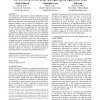Free Online Productivity Tools
i2Speak
i2Symbol
i2OCR
iTex2Img
iWeb2Print
iWeb2Shot
i2Type
iPdf2Split
iPdf2Merge
i2Bopomofo
i2Arabic
i2Style
i2Image
i2PDF
iLatex2Rtf
Sci2ools
CHINZ
2005
ACM
2005
ACM
The territory is the map: designing navigational aids
It has been shown that people encounter difficulties in using representations and devices designed to assist navigating unfamiliar terrain. Literature review and self-reported visual and textual data from field experiments are presented. This suggests usability may be limited by assumptions about landmarks implicit in designing representations. Firstly, memorable landmarks are emphasized but route following in situ requires recognizable landmarks. Secondly, little emphasis is placed on differences between landmarks contributing to higher-level concepts related to wayfinding and those directly provoking actions in the environment. Studies analyse landmarks in SMS during collaborative wayfinding to an unfamiliar rendezvous and in images to communicate routes in unfamiliar terrain. Findings illustrate usability benefits for navigation aids.This includes helping users to align a landmark’s illustration to their individual perspective in the environment. It also includes identifying land...
CHINZ 2005 | Human Computer Interaction | Navigating Unfamiliar Terrain | Studies Analyse Landmarks | Unfamiliar Terrain |
| Added | 13 Oct 2010 |
| Updated | 13 Oct 2010 |
| Type | Conference |
| Year | 2005 |
| Where | CHINZ |
| Authors | Nicola J. Bidwell, Christopher Lueg, Jeff Axup |
Comments (0)

